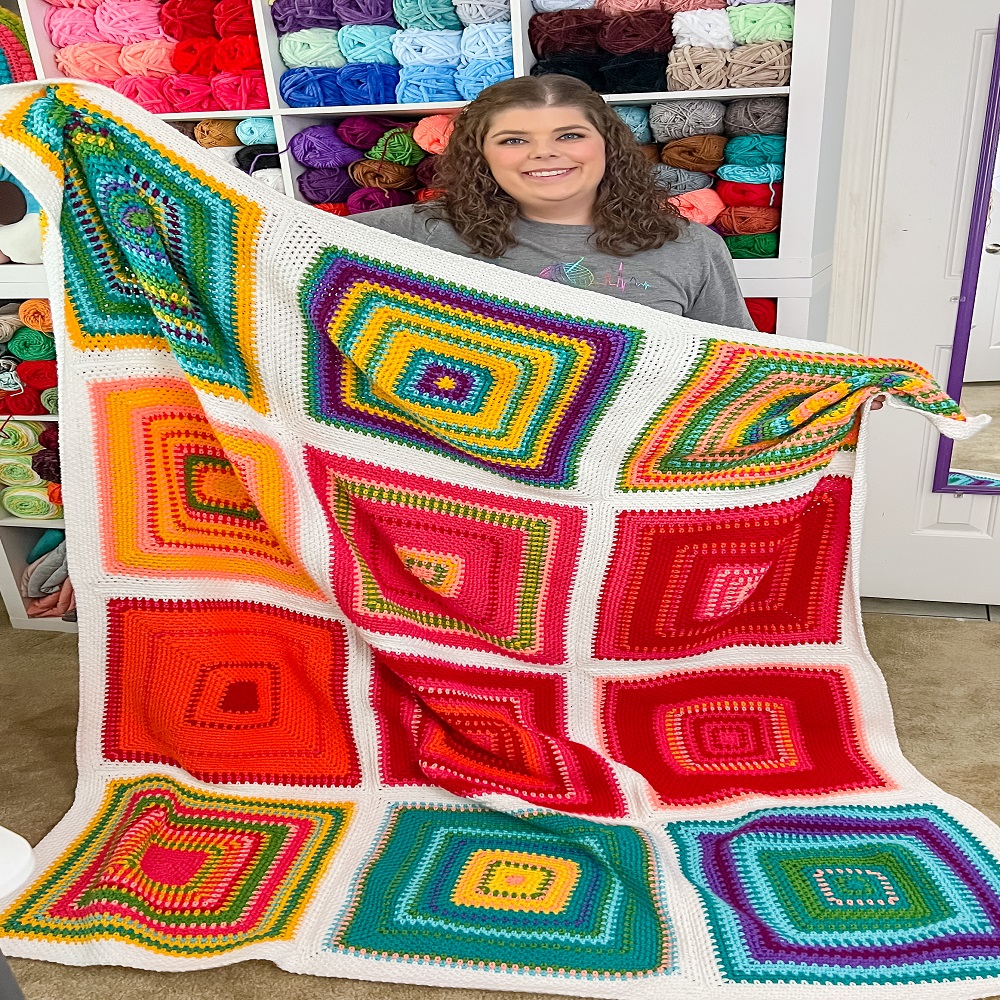Introduction
Weather blanket represent a groundbreaking innovation in personal comfort, designed to respond dynamically to changes in ambient temperature, ensuring optimal warmth and coziness throughout the year. These technologically advanced blankets integrate smart materials and design principles to provide a personalized sleep and relaxation experience, adapting to the user’s needs and environmental conditions. Here, we delve into the concept behind these revolutionary blankets and explore the numerous benefits they offer.

Understanding the Technology Behind Weather-Adaptive Blankets
Smart Materials
At the heart of weather-adaptive blankets lie smart fabrics or phase-changing materials (PCMs). PCMs are engineered to absorb, store, and release heat as the surrounding temperature fluctuates. When the ambient temperature drops, these materials solidify, releasing stored heat to keep the user warm. Conversely, when the temperature rises, they liquefy, absorbing excess heat to prevent overheating. This self-regulating mechanism ensures a consistent microclimate around the body, promoting restful sleep and comfort.
Breathable Layers and Moisture Management
In addition to PCMs, these blankets often incorporate breathable layers and moisture-wicking technologies to enhance breathability and prevent clamminess. This is particularly important for maintaining a comfortable sleeping environment, as it helps regulate humidity and reduces the likelihood of waking up due to discomfort caused by sweat or overheating.
Intelligent Controls
Some high-end weather-adaptive blankets come equipped with sensors and integrated controls, allowing users to customize their experience further. These systems can monitor room temperature and adjust the blanket’s heat retention capabilities accordingly, or even connect to smart home systems for voice-activated or app-controlled adjustments.
Benefits of Weather-Adaptive Blankets
Enhanced Sleep Quality
By maintaining an optimal temperature throughout the night, weather-adaptive blankets contribute significantly to improved sleep quality. They help regulate body temperature, a critical factor in the sleep cycle, promoting deeper and more restorative sleep phases.
Energy Efficiency
These blankets can also contribute to energy savings by reducing the need for heating or cooling systems during sleep. By keeping individuals comfortable without having to adjust the thermostat, they indirectly lower energy consumption and utility bills, making them an eco-friendly choice.
Year-Round Comfort
One of the most notable benefits is their versatility. Whether it’s the chilly nights of winter or the warm evenings of summer, weather-adaptive blankets adjust accordingly, eliminating the need for multiple blankets or seasonal switches.
Health and Wellness
Maintaining a stable body temperature is vital for overall health. Excessive heat or cold can disrupt sleep patterns,影响 hormone regulation, and exacerbate certain medical conditions. Weather-adaptive blankets promote a balanced thermal environment, potentially benefiting individuals with conditions like insomnia, menopausal hot flashes, or circulatory problems.
Convenience and Luxury
The convenience of having a blanket that automatically adjusts to your needs cannot be overstated. Users no longer have to toss and turn searching for the perfect balance between too many or too few covers. This level of personalization adds a touch of luxury to everyday life.

Understanding Weather-Adaptive Blankets
Weather-adaptive blankets are engineered to respond to changes in temperature and environmental conditions. Unlike traditional blankets that offer static warmth, these blankets utilize advanced materials and technologies to adjust their thermal properties based on external factors such as temperature, humidity, and airflow. This adaptability ensures that users remain comfortable and snug, whether it’s a chilly winter evening or a breezy summer night.
Technology Behind Weather-Adaptive Blankets
- Phase Change Materials (PCMs): Many weather-adaptive blankets incorporate phase change materials, which are substances capable of storing and releasing thermal energy as they change from solid to liquid and vice versa. PCMs absorb heat when the temperature rises, keeping the blanket cool, and release heat when the temperature drops, providing warmth.
- Thermal Insulation Layers: These blankets often feature multiple layers of insulation designed to trap heat in cold weather and maintain a comfortable temperature in warmer conditions. High-quality insulating materials like down, synthetic fibers, or wool are commonly used for effective thermal regulation.
- Breathable Fabrics: The outer fabric of weather-adaptive blankets is typically breathable to allow moisture and excess heat to escape, preventing overheating and ensuring a dry and comfortable sleep environment.
- Smart Textiles: Some advanced blankets may incorporate smart textile technologies that actively respond to changes in body temperature or ambient conditions, further enhancing comfort and adaptability.
Benefits of Weather-Adaptive Blankets
- Year-Round Comfort: Weather-adaptive blankets are designed to be versatile, providing comfort across different seasons. They adapt to keep you warm in winter and cool in summer, eliminating the need for multiple blankets throughout the year.
- Enhanced Sleep Quality: By maintaining an optimal temperature and humidity level, these blankets promote better sleep quality. They help regulate body temperature fluctuations during the night, reducing restlessness and promoting deeper sleep.
- Energy Efficiency: The thermal-regulating properties of weather-adaptive blankets can contribute to energy savings by reducing reliance on heating and cooling systems, especially when used in conjunction with proper room temperature management.
- Portability and Convenience: Lightweight and easily portable, these blankets are convenient for travel and outdoor activities. They offer comfort wherever you go, adapting to varying weather conditions effortlessly.
- Health Benefits: Maintaining a comfortable sleeping environment with the right temperature can have positive effects on overall health and well-being. Weather-adaptive blankets contribute to thermal comfort, supporting relaxation and stress reduction.
Choosing the Right Weather-Adaptive Blanket
When selecting a weather-adaptive blanket, consider factors such as:
- Material: Opt for high-quality materials that offer both comfort and durability.
- Design: Choose a design that suits your preferences, whether you prefer a weighted blanket, quilted pattern, or a sleek, modern style.
- Technology: Evaluate the technology used, such as PCM integration or smart textile features, based on your specific comfort needs.

Innovations in Design and Personalization
Customizable Designs
Weather-adaptive blankets are not only functional but increasingly fashionable. Manufacturers are incorporating a range of designs, colors, and textures to complement any bedroom decor. From sleek and minimalist to plush and cozy, consumers now have the option to choose a blanket that matches their personal style without compromising on the technology.
Size and Weight Variations
Recognizing that one size does not fit all, manufacturers offer a variety of sizes to accommodate different bed types and personal preferences. Lightweight versions are available for those who prefer less weight while sleeping, while heavier options cater to those who find the extra weight comforting. This attention to detail ensures a personalized fit and feel for every user.
Integration with Sleep Tracking Technology
Advanced models integrate with wearable devices or standalone sleep trackers, collecting data on sleep patterns, body temperature fluctuations, and environmental conditions. Using this data, the blanket can learn and adapt over time, tailoring its performance to an individual’s unique sleep needs. This level of customization takes personalized comfort to a whole new level.
Environmental Sustainability
Sustainability is another aspect gaining importance in the production of weather-adaptive blankets. Many manufacturers are using recycled materials, organic fibers, and eco-friendly production processes to minimize their environmental footprint. Biodegradable PCMs and low-energy manufacturing techniques are being explored to create blankets that are not only comfortable but also responsible choices for environmentally conscious consumers.
The Future of Weather-Adaptive Blankets
As technology advances, we can expect weather-adaptive blankets to become even smarter. Integration with AI-powered home systems could allow the blanket to proactively adjust based on weather forecasts, personal schedules, and even individual health metrics. Wearable technology might further personalize the experience by communicating real-time physiological data to the blanket’s control system.
Moreover, advancements in material science may lead to the development of even more efficient PCMs, capable of reacting faster and with greater precision to temperature changes. This could result in even greater energy savings and an enhanced user experience.
Conclusion
Weather-adaptive blankets are more than just a bedding accessory; they symbolize the fusion of technology and comfort, revolutionizing the way we sleep and relax. By offering personalized temperature regulation, they promise improved sleep quality, energy efficiency, year-round suitability, health benefits, and unparalleled convenience. As technology continues to advance, these blankets are poised to become a staple in modern households, redefining what it means to truly rest in comfort.
